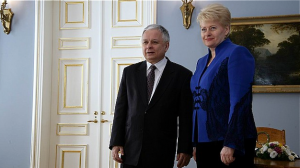
Polish President Lech Kaczyński (left) and Lithuanian President Dalia Grybauskaitė meet in Vilnius' Presidential Palace on Thursday, two days before Kaczyński death. During the meeting Kaczyński criticized Lithuania's spelling restrictions, which Grybauskaitė agreed to resolve.
VILNIUS — Following the shocking death of Lech Kaczyński, the Vilnius municipal government will name a street after the former Polish head of state, but in spite of the president’s work on the issue, the name of the street will be in Lithuanian letters.
Kaczyński was an ardent supporter of changes to the Lithuanian law that prohibits Poles from writing their name in Latin characters that don’t appear in the Lithuanian alphabet, such as w. Just days before his death, the president said that he wanted the law changed so ethnic Poles could write their names in the correct letters. The thorny political issue has plagued relations between the two allies for years. About 200,000 ethnic Poles live in Lithuania, 6 percent of the total population, concentrated in the southeastern area of the country.
Vilnius Vice Mayor Vidmantas Martinkonis told local media Tuesday that the final decision would be made on Wednesday to name a street after the president, who died in a plane crash with 96 others on Saturday near Smolensk airport in western Russia.
The street to be renamed is currently officially nameless, but carries the sign K. Sirvydo, next to the Gedimino 9 shopping mall near the Vilnius Cathedral on Gedimino Prospect.
In spite of the Polish president’s optimism that the law could be changed, a position he stated in Vilnius to Lithuanian President Dalia Grybauskaitė just two days before his death, the street name will be remade into its Lithuanian equivalent — Kačinskio Street.
“We are not planning to write the name of the street in original language, as we are following the Lithuanian constitution,” Martinkonis said.
The move is being made in haste — usually it takes much longer before deceased persons have streets named after them.
The vice mayor admitted that the municipal government had been asked behind closed doors by the Ministry of Foreign Affairs to speed up the process.
Streets are named by the victors
Before the Second World War, most of Vilnius’ streets had Polish names, as the city was then part of Poland and had a majority ethnic Polish and Jewish population. After WWII decimated the populace, the city was incorporated into the Lithuanian Soviet Socialist Republic and an influx of ethnic Lithuanians moved in and the Polish street names were largely replaced with Soviet ones.
When Lithuania’s independence was restored in 1990, the streets were renamed again, this time reflecting Vilnius’ heritage as the medieval capital of the Grand Duchy of Lithuania and as the new capital of modern-day Lithuania.
This article is free to view. To read Baltic Reports’ subscription-only articles, click here.













[…] bietet einen weitreichenden Ausblick über Kaczynski gets street name in Lithuanian letters | balticreports.com Gerät als der Ehering gegrilltem oder gebratenem Fleisch belieben!In Deutschland gibt es Gold […]